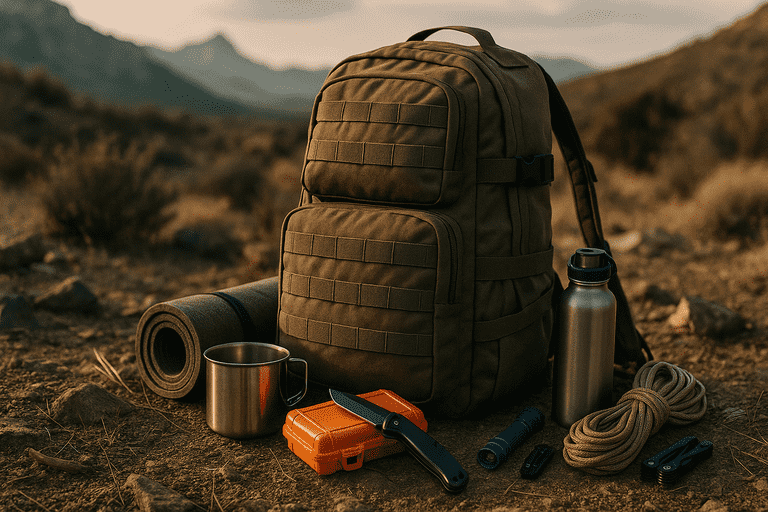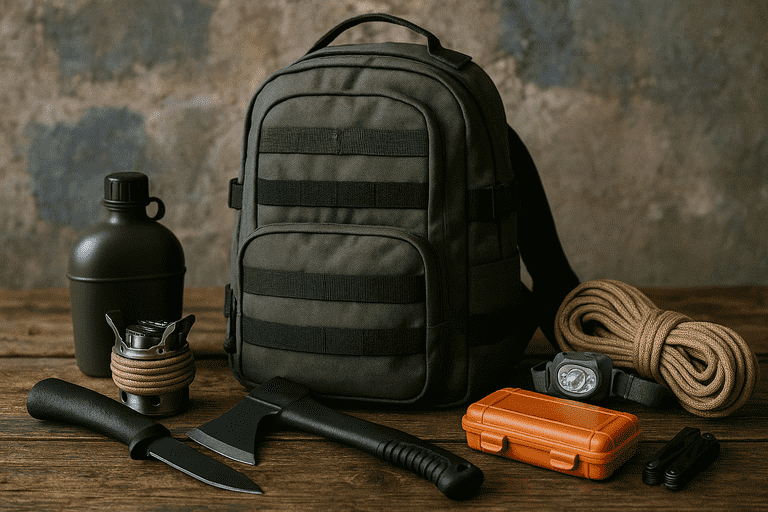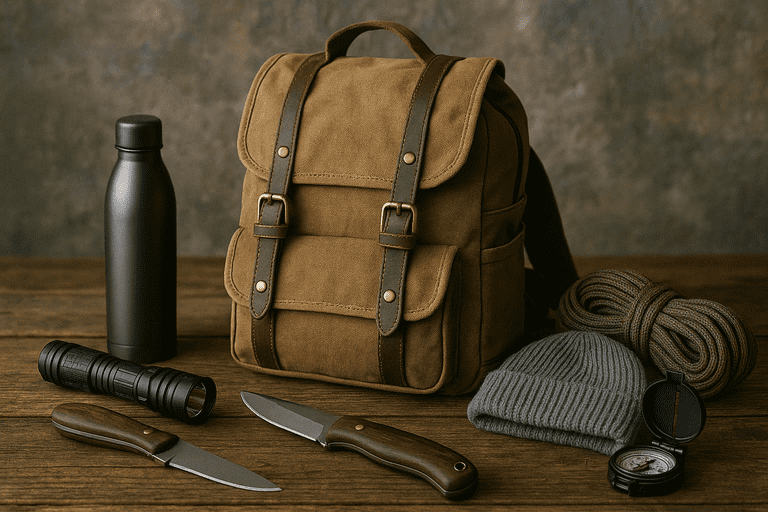What Makes a Great Survival Backpack Kit?
Preparation is a mindset, not just a task. The right survival backpack kit gives you the ability to respond quickly and effectively when emergencies strike. For instance, whether you’re lost on a trail, stranded in a vehicle, or facing a natural disaster, having the correct tools and supplies can be life-saving. Therefore, choosing the right gear isn’t just important—it’s essential.
In addition, the kit should be lightweight but versatile, filled with multi-purpose tools that minimize space and maximize function. Prioritize essentials first: water, food, shelter, and first aid. Afterward, customize the kit to your personal needs, climate, and regional threats.
Essential Items to Include in Your Survival Backpack Kit
To build a dependable survival backpack kit, start by covering the basics. Include a reliable water purification system like a filter straw or iodine tablets. For shelter, compact emergency blankets or a lightweight bivy sack can provide insulation. Fire starters, like waterproof matches or a ferro rod, are also essential.
Why Cheap Survival Gear Can Still Save Your Life
In addition, a high-calorie food supply, such as energy bars or freeze-dried meals, offers necessary nutrition. Don’t forget a basic medical kit with antiseptics, bandages, and pain relief. For instance, a multitool, flashlight with extra batteries, paracord, and a whistle serve multiple purposes. Therefore, every item in the bag should serve more than one function when possible.

Choosing the Right Survival Backpack Kit for Your Situation
No two survival situations are alike. Therefore, when selecting a survival backpack kit, consider your location, environment, and personal experience. For instance, urban survivalists may need gear for navigating buildings or treating injury in crowded settings. Wilderness adventurers, by contrast, must plan for navigation, animal encounters, and environmental exposure.
In addition, your bag’s capacity and layout matter. A tactical backpack with MOLLE webbing allows for customization and expansion. Look for durable materials like nylon or Cordura fabric. Padded shoulder straps and breathable back panels increase comfort during long treks. However, avoid overpacking—the most efficient kit balances preparedness and portability.
Seasonal Adaptations to Your Survival Backpack Kit
Environmental conditions greatly affect your survival strategy. For instance, winter requires items like insulated gloves, heat packs, and waterproof layers. During hot weather, hydration becomes a priority, so your survival backpack kit should include electrolyte tablets and sun protection.
Why Cheap Survival Gear Can Still Save Your Life
In addition, consider the risk of flooding in spring or wildfires in dry summer months. Therefore, adapt your gear regularly. Make it a habit to review and update your kit every three months. Check expiration dates, replace used items, and rotate food and water. This keeps your pack not only well-stocked but also reliable year-round.

Skills That Complement Your Survival Backpack Kit
Having the gear is only part of survival—knowing how to use it is what truly matters. Therefore, practice makes perfect. For instance, spend time learning how to start a fire in wet conditions, apply a tourniquet correctly, or navigate with a compass. Take your survival backpack kit on training hikes and simulated drills.
In addition, basic knowledge of local flora, weather patterns, and wildlife behavior can increase your odds in an emergency. The more skills you develop, the more confident and capable you become. A well-trained individual with a basic kit will almost always outperform an untrained person with a high-end pack.
Survival Backpack Kit for Vehicle and Urban Use
Not all emergencies happen in the wilderness. A survival backpack kit is equally valuable in urban or vehicular settings. For instance, being stranded in your car during a snowstorm or stuck in traffic during a wildfire evacuation calls for fast action. Therefore, keeping a secondary kit in your vehicle is a smart decision.
In addition, urban kits should include dust masks, gloves, emergency cash, local maps, and small pry tools. City dwellers may also need signaling mirrors, reflective vests, or basic self-defense items. Each component should be easy to access and designed for fast deployment. After all, in cities, time is often your most precious resource.
Family and Group Considerations When Assembling a Kit
When preparing for more than one person, your survival backpack kit must scale accordingly. For instance, more people mean more water, food, and medical supplies. However, duplicating every item isn’t always efficient. Instead, assign roles and divide gear by specialty—navigation, first aid, food preparation, etc.
Best Bug Out Bag: The Ultimate Guide for Emergency Preparedness
In addition, group kits should include communication tools like two-way radios, especially in areas with poor cell service. Children and elderly members will have specific needs as well—medications, comfort items, or mobility aids. Therefore, consider the composition of your group and tailor each bag to ensure everyone’s needs are met.

Long-Term Preparedness and Kit Maintenance
Your survival backpack kit isn’t a “set it and forget it” solution. Like any emergency tool, it requires regular attention and updates. For instance, rotate food and water storage every 3–6 months, check battery-powered gear monthly, and reevaluate your loadout based on changing risk factors.
In addition, keep an inventory checklist in a waterproof pouch inside the bag. This ensures that any time an item is used, it’s easy to replace. Maintenance also includes inspecting zippers, straps, and seams for wear. Therefore, a well-maintained kit is far more dependable than one that’s been neglected.
Recommended Tools and Gear Brands to Consider
When sourcing gear for your survival backpack kit, not all equipment is created equal. For instance, brands like Sawyer and LifeStraw offer proven water filtration. Morakniv and Gerber make excellent fixed-blade knives that are durable and easy to maintain. In addition, Osprey and 5.11 Tactical provide high-quality backpacks suitable for rugged use.
However, price doesn’t always reflect performance. Sometimes, budget-friendly gear performs just as well with proper use. Therefore, focus on user reviews, real-world tests, and product warranties. In survival, dependability always outweighs bells and whistles.
Most Common Mistakes When Building a Survival Backpack Kit
Even well-intentioned preppers make critical errors when assembling a survival backpack kit. For instance, overpacking is one of the most frequent problems. Carrying 60+ pounds of gear may seem impressive—until you’re exhausted after 2 miles. Another common issue is relying on unfamiliar tools without practice.
In addition, some people prioritize novelty over practicality. While it’s fun to pack exotic gear, essentials like clean socks or duct tape often go ignored. Therefore, keep things simple and proven. A minimalist, functional approach beats a complicated setup every time. Experience and efficiency are your true assets.
Technology and the Survival Backpack Kit: What to Include
Technology can play a supportive role in any survival backpack kit, if used wisely. For instance, solar-powered flashlights or portable chargers extend your ability to communicate or navigate. GPS trackers and emergency beacons provide peace of mind in case you’re out of signal range.
However, overreliance on tech is risky. Batteries die, screens crack, and water damage is always a concern. Therefore, every technological item should have a non-electronic backup: a compass for navigation, matches for fire, or a paper map. That way, you’re never caught unprepared if tech fails.
Frequently Asked Questions About Survival Backpack Kits
1. How heavy should a survival backpack kit be?
Ideally, it should weigh no more than 20–25% of your body weight. For instance, if you weigh 80 kg, aim for a max pack weight of 16–20 kg.
2. Should I build my own kit or buy a pre-made one?
If you’re a beginner, a pre-made kit is a great start. However, customizing your own survival backpack kit ensures you have exactly what you need—and know how to use it.
3. How often should I update my kit?
Every 3–6 months is ideal. Therefore, rotate perishables, test electronics, and adjust based on seasonal changes or new personal needs.

